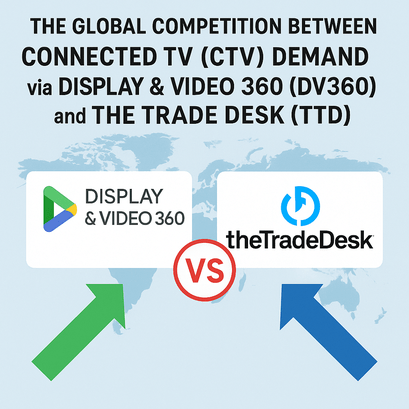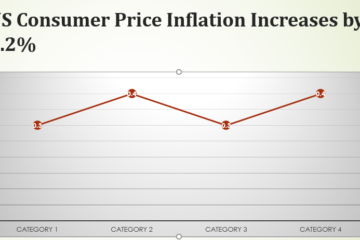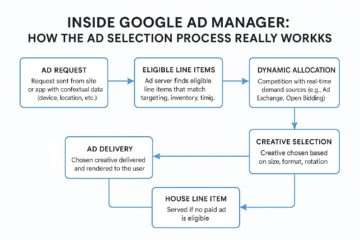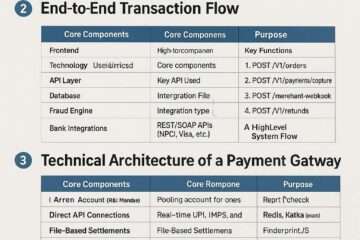

Connected TV (CTV) advertising has emerged as a powerhouse in the digital advertising ecosystem, bridging the gap between traditional TV’s mass reach and digital’s precise targeting. As consumer behavior shifts toward streaming platforms, two demand-side platforms (DSPs)—Google’s Display & Video 360 (DV360) and The Trade Desk (TTD)—dominate the global CTV advertising landscape. This article explores the competition between DV360 and TTD for CTV demand, evaluates their strengths and weaknesses, and examines the future of CTV ads in ad-supported OTT subscription models and the challenges ahead.
The Global Competition: DV360 vs. The Trade Desk
Display & Video 360 (DV360) is Google’s DSP, integrated within the Google Marketing Platform, offering advertisers access to a vast ecosystem of inventory, including premium CTV and OTT platforms. It leverages Google’s data, analytics, and programmatic buying capabilities to deliver targeted campaigns across devices.
The Trade Desk (TTD) is an independent DSP known for its transparency, flexibility, and focus on programmatic advertising. TTD has carved out a significant share of the CTV market by prioritizing open internet advertising and partnerships with major CTV publishers and supply-side platforms (SSPs).
Both platforms compete fiercely for CTV ad spend, which is projected to reach $38 billion globally by 2026. Their competition is driven by differences in inventory access, targeting capabilities, transparency, and integration with broader marketing ecosystems. Below, we analyze their strengths and weaknesses for CTV advertising.
Which Platform is Better for CTV Advertising?
Determining whether DV360 or TTD is “better” depends on an advertiser’s goals, budget, and technical requirements. However, a comparative analysis of their features highlights key differentiators.
Pros and Cons of DV360 for CTV Advertising
Pros:
- Extensive Inventory Access: DV360 provides access to Google’s vast ad network, including YouTube, Google TV, and premium OTT platforms like Hulu and Roku. This makes it ideal for advertisers seeking scale and premium inventory.
- Integrated Ecosystem: As part of the Google Marketing Platform, DV360 seamlessly integrates with tools like Campaign Manager, Google Analytics 360, and Data Studio, enabling unified reporting and attribution.
- Advanced Audience Targeting: DV360 leverages Google’s first-party data (e.g., search and YouTube behavior) and third-party data for precise audience segmentation based on demographics, interests, and behaviors.
- Programmatic Buying Options: DV360 supports multiple buying types, including Programmatic Guaranteed deals, Private Auctions, and Open Bidding, offering flexibility for CTV campaigns.
- Creative Tools: Features like the Video Creative Builder and tagless trafficking streamline ad creation and delivery, particularly for brands new to CTV.
Cons:
- Walled Garden Limitations: DV360 operates within Google’s ecosystem, which can limit transparency into supply paths and inventory sources compared to TTD’s open approach.
- Higher Costs: Premium inventory and Google’s fees can make DV360 more expensive, especially for smaller advertisers or those targeting niche audiences.
- Complexity: The platform’s extensive features can be overwhelming for advertisers without advanced programmatic expertise.
- Limited Direct Publisher Relationships: Some premium CTV inventory, like Twitch, is not available in DV360’s marketplace, requiring direct buys outside the platform.
Pros and Cons of The Trade Desk for CTV Advertising
Pros:
- Transparency and Flexibility: TTD’s open internet approach provides greater visibility into supply chains, impression-level data, and bidding processes, appealing to advertisers prioritizing control.
- Robust CTV Partnerships: TTD has strong relationships with major CTV publishers (e.g., Roku, Samsung Ads, Pluto TV) and SSPs, ensuring access to high-quality inventory. Its 40% year-over-year growth in CTV spend in Q2 2020 underscores its market strength.
- Unified ID 2.0: TTD’s identity solution enhances cross-device targeting and measurement in a cookie-less world, a critical advantage for CTV’s fragmented ecosystem.
- Cost Efficiency: TTD’s independent model often results in lower fees and more competitive pricing compared to DV360, making it attractive for mid-sized advertisers.
- Advanced Optimization Tools: Features like Koa (TTD’s AI-driven optimization engine) enable real-time campaign adjustments to maximize ROI.
Cons:
- Limited Integration: Unlike DV360, TTD lacks a native ad server or analytics suite, requiring advertisers to integrate third-party tools for reporting and attribution.
- Learning Curve: TTD’s interface and advanced features can be complex for beginners, necessitating experienced media buyers.
- Smaller Data Ecosystem: While TTD supports third-party data, it lacks the scale of Google’s first-party data, potentially limiting audience targeting depth for some campaigns.
- Inventory Gaps: TTD may not access certain Google-controlled inventory (e.g., YouTube CTV), which can be a drawback for advertisers seeking comprehensive reach.
Verdict: Which is Better?
- Choose DV360 if you prioritize scale, premium inventory, and integration with Google’s ecosystem. It’s ideal for large brands with complex, cross-channel campaigns and access to Google’s data.
- Choose TTD if transparency, cost efficiency, and flexibility are critical. It’s better suited for advertisers focused on programmatic CTV buys, open internet advertising, or those avoiding Google’s walled garden.
Ultimately, many advertisers use both platforms to maximize reach and optimize performance, leveraging DV360 for Google’s inventory and TTD for its transparency and CTV-specific partnerships.
The Future of CTV Ads in Ad-Supported OTT Subscription Models
The rise of ad-supported video-on-demand (AVOD) tiers on OTT platforms like Netflix, Amazon Prime Video, and Zee5 signals a transformative shift in the CTV advertising landscape. As subscription fatigue grows and consumers seek cost-effective streaming options, AVOD models are gaining traction. For example, Netflix and Disney+ introduced ad-supported tiers in 2022, while Amazon Prime Video launched an ad tier in 2024, contributing to a projected $5.06 billion increase in digital upfront spending. Below, we explore the future of CTV ads in these models.
Key Trends in AVOD OTT Platforms
- Mass Adoption of Ad-Supported Tiers: 73% of CTV viewers prefer free or discounted ad-supported content over ad-free subscriptions, driving platforms like Netflix and Zee5 to offer lower-cost AVOD plans. This democratizes access and expands ad inventory.
- Premium Content with Ads: OTT giants are investing billions in original content (e.g., Amazon’s $465 million on The Rings of Power), pairing high-quality programming with non-skippable ads to attract engaged audiences.
- Interactive Ad Formats: Shoppable ads, pause ads, and QR code integrations are enhancing viewer engagement. Interactive CTV campaigns deliver 4.6x higher engagement than mobile video and 10.3x higher than desktop video.
- Data-Driven Personalization: OTT platforms collect rich first-party data, enabling hyper-targeted ads. For instance, Netflix’s ad tier uses viewing history to serve relevant ads, improving conversion rates by 25%.
- Global Expansion: In markets like India, where Zee5 and Disney+ Hotstar dominate, CTV ad spend is growing due to affordable data plans and smart TV penetration (48 million Indian households own CTVs).
Impact on Advertisers
- Increased Inventory: AVOD tiers expand premium ad slots, reducing reliance on house ads (e.g., NBC ads on Peacock) and offering diverse demand.
- Higher ROI: Non-skippable ads and engaged audiences improve view-through rates and conversions, with 18% of marketers reporting increased returning customers.
- Cross-Platform Synergy: Platforms like Amazon integrate CTV ads with e-commerce, enabling seamless purchase funnels (e.g., shoppable ads on Fire TV).
Challenges for OTT Platforms
- Balancing User Experience: Too many ads risk alienating subscribers, as seen with early complaints about Netflix’s ad tier frequency.
- Ad Fraud and Brand Safety: Ensuring ads appear in safe environments and combating invalid traffic remain critical, especially in fragmented markets like India.
- Standardized Metrics: Varying measurement standards across platforms (e.g., Netflix vs. Zee5) complicate campaign evaluation.
Future Challenges in CTV Advertising
As CTV continues to grow, advertisers, DSPs, and OTT platforms face several challenges that could shape the industry’s trajectory.
- Fragmentation: The CTV ecosystem is highly fragmented, with over 300 OTT providers and devices like Roku, Fire TV, and gaming consoles. This complicates inventory access and measurement, as 57% of marketers cite unreliable measurement as a barrier.
- Ad Fraud and Invalid Traffic: Fraudulent impressions and bots inflate costs, particularly in emerging markets. Trusted platforms with fraud detection are essential.
- Privacy Regulations: Stricter laws (e.g., GDPR, CCPA) and the phasing out of third-party cookies challenge targeting accuracy. Solutions like TTD’s Unified ID 2.0 and data clean rooms (DCRs) are critical for privacy-compliant data collaboration.
- Signal Fidelity: Inaccurate user data due to device fragmentation reduces targeting precision. Improving signal fidelity is a priority for DSPs like TTD and StackAdapt.
- Inventory Scarcity: Premium CTV inventory is limited, with much of it controlled by direct deals or private marketplaces, making it harder for smaller advertisers to compete.
- Ad Fatigue: Overloading viewers with repetitive or irrelevant ads risks disengagement, especially on AVOD platforms balancing user experience and revenue.
- Evolving Technology: Rapid advancements in CTV devices and AI-driven personalization require continuous investment in infrastructure and creative development.
Conclusion
The competition between DV360 and The Trade Desk for CTV advertising reflects their distinct strengths: DV360 excels in scale and integration, while TTD prioritizes transparency and flexibility. Advertisers often benefit from using both to optimize reach and performance. The rise of ad-supported OTT models on platforms like Netflix, Amazon Prime Video, and Zee5 is reshaping CTV advertising, offering premium inventory and engaged audiences. However, challenges like fragmentation, ad fraud, and privacy regulations demand innovative solutions, such as data clean rooms and identity frameworks.
As CTV ad spend soars and consumer adoption accelerates, advertisers must navigate a complex but opportunity-rich landscape. By leveraging the strengths of DSPs like DV360 and TTD and adapting to emerging trends, brands can harness CTV’s potential to deliver impactful, data-driven campaigns in the streaming era.




























































